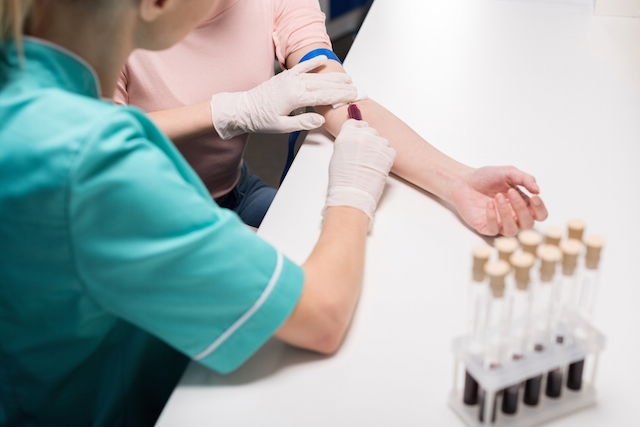What is it:
Homocysteine is an amino acid that is often associated with an increased risk for cardiovascular disease (CVD), such as stroke, coronary artery disease, thrombosis or heart attack. High levels of homocysteine can cause structural changes to blood vessels.
Normally, a cardiologist or family will order a homocysteine test to evaluate the concentration of this amino acid in the blood. This result can help assess the need to start treatment to prevent the cardiovascular problems.
Normal homocysteine values are usually below 15 µmol/L, although the reference value may vary slightly from lab to lab. The test is usually done after a 12-hour fast, or as prescribed by a doctor.

When the homocysteine test is ordered
The homocysteine test is normally ordered to determine the risk for CVD. A higher level is generally related to a higher risk of heart attacks, clots and stroke.
Homocysteine tests can also be beneficial for monitoring thyroid-related problems and kidney diseases, as changes in this amino acid can be noted with these conditions. It is important for homocysteine test results to be evaluated by the ordering doctor alongside other blood tests that may have been ordered.
Normal levels
Normal level may vary from lab to lab. Homocysteine levels are considered to be normal when they are between 5 and 15 µmol/L. Values above this typically represent a greater cardiovascular risk. High levels of homocysteine can lead to structural changes in the blood vessels and promote platelet aggregation, leading to clot formation.
To determine the risk for cardiovascular disease, reference values are usually:
- Low CVD risk: between 15 to 30 µmol/L
- Moderate CVD risk: between 30 to 100 µmol/L
- High CVD risk: over 100 µmol/L
The doctor can use this test result to determine the most appropriate form of treatment. Values below the reference value can also be treated, as low levels can be a sign of reduced immunity and increased oxidative stress (which can lead to cellular death and toxic effects on the body).
Some medications can interfere with the test results, and show falsely high homocysteine levels in the blood. Therefore, it is important to inform the laboratory and your doctor of any medication you are taking, so that these are taken into account at the time of analysis.
What results mean
Homocysteine results should be evaluated by the doctor, who will take other blood test results and your health history into consideration.
1. Low homocysteine levels
Homocysteine levels are considered to be low when tests result are less than 5 µmol/L. This can happen mainly due to vitamin B or folic acid supplementation (especially during pregnancy), as these substances reduce homocysteine levels in the blood.
Normally, values that are slightly below the reference value are not concerning. Very low levels, however, can cause cellular damage, as low levels are related to a reduced production of antioxidants. This can lead to the accumulation o toxic substances in the body.
Homocysteine levels that are very low for no apparent reasons should be assessed by the ordering doctor, as it may be a sign of low production of this amino acid.
What to do: When the cause of low homocysteine levels is related to vitamin B or folic acid supplementation, the doctor will recommend interrupting or changing the dosage of the supplementation until levels return to normal.
In other cases, dietary changes may be recommended to reduce the intake of foods rich in vitamin B6 and B12, such as fish, bananas, avocados and vegetables, as well as folate, such as beans, spinach and lentils.
2. High homocysteine levels
Homocysteine levels are considered to be high when the concentration of this amino acid is greater than 15 µmol/L. This can occur as a result of a protein-rich diet (e.g. excess red meat intake), as these foods are rich in homocysteine. A high homocysteine diet can cause damage to the inner walls of the blood vessels, leading to a higher risk for cardiovascular diseases.
High homocysteine levels can also be caused by:
- Genetic mutations that interfere with the metabolism of homocysteine, like a methylene mutation
- Low intake of foods with vitamin B6, vitamin b12 or folic acid
- Thyroid problems
- Kidney disease
- Using certain medications
- Smoking
- Severe cases of COVID-19 infection
Whenever an increase in homocysteine levels is noted, it is important to consult your doctor. Higher levels of this amino acid are related to a greater risk for clot formation, which can be life-threatening. Increased homocysteine levels can act directly on the blood vessels and activate platelets and clotting factors, resulting in clots.
To assess the risk for thrombosis, your doctor may additionally order tests like coagulation factors, platelet levels, d-dimer levels, vitamins levels and thyroid hormones to investigate for other possible causes.
How to lower homocysteine levels
Treatment to lower homocysteine should be prescribed by a doctor in conjunction with the registered dietitian, as this approach will yield in the best optimal results.
You may be advised to make changes to the diet, such as increasing the intake of foods that are rich in folic acid, vitamin B6 and vitamin B12. Examples include beans, broccoli, spinach, nuts, bananas and grilled fish. You may also be advised to reduce or avoid any consumption of red meat and seafood.
It is important that these foods are consumed as advised by a registered dietitian, as excess quantities can lead to high levels of homocysteine. This can also increase your risk for complications, mainly related to the cardiovascular system.
In some cases, when food is not enough effective in lowering homocysteine levels, the doctor may also prescribe supplements with folic acid, vitamin B12, taurine or betaine.






























